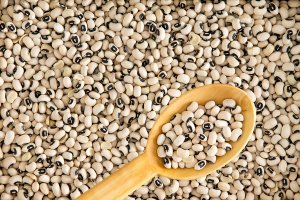
The name “black-eyed” (“mavromatika”) came from the black spot which looks like an eye. In Roumeli, they are called “mavroselachakides” (“mavro”= black, “selachi”=belt) because the black spot looks like a belt.
They are served either as a cold salad with various raw vegetables or in a casserole with spinach or chard.
In Greece, they are produced in several regions, like Preveza and Kastoria. The countries with the largest production of black-eyed beans are Nigeria, Madagascar, Peru and the United States.
Properties
Black-eyed beans or “louvia” are rich in metals, proteins and trace elements. A cup of black-eyed beans covers 45% of the daily body needs in vegetable fibres, 58% in folic acid and 31% in proteins.
Combined with some cereal (e.g. rice), these beans provide us with proteins that are equivalent with the proteins of meat and fish.
In addition, they contain vitamin B1 which contributes to the main functions of metabolism, to the proper functioning of brain cells, to the preservation of memory and cognitive abilities.

